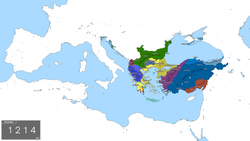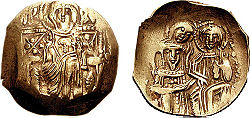Empire of Nicaea
The Empire of Nicaea (Greek: Βασίλειον τῆς Νίκαιας) was the largest of the Byzantine Greek states founded by the nobility of the Byzantine Empire after Constantinople was conquered during the Fourth Crusade. It lasted from 1204 to 1261.
Empire of Nicaea Βασίλειον τῆς Νίκαιας | |||||||||
|---|---|---|---|---|---|---|---|---|---|
| 1204–1261 | |||||||||
 The Empire of Nicaea in 1204, shortly after the Fourth Crusade | |||||||||
| Capital | Nicaea | ||||||||
| Common languages | Greek | ||||||||
| Religion | Eastern Orthodox Church | ||||||||
| Government | Monarchy | ||||||||
| Emperor | |||||||||
• 1204 – 1222 | Theodore I Lascaris | ||||||||
• 1222 – 1254 | John III Ducas Vatatzes | ||||||||
• 1254 – 1258 | Theodore II Lascaris | ||||||||
• 1258 – 1261 | John IV Lascaris | ||||||||
• 1259 – 1261 | Michael VIII Palaeologus | ||||||||
| Historical era | High Medieval | ||||||||
• | 1204 | ||||||||
• | July 1261 | ||||||||
| |||||||||
Founded by the Laskaris Dynasty it would be the Byzantine rump-state to recapture Constantinople in 1261 and reform the Byzantine Empire and is seen as the continuation of the Byzantine Empire.
The Despotate of Epirus contested the claim in 1224 and became the Empire of Thessalonica, but was forced to renounce their claim by the Nicenes in 1242. The Empire of Trebizond declared its independence a few weeks before the Sack of Constantinople in 1204, ended their claim of being a continuation of the Byzantines in the Treaty of 1282.
Empire Of Nicaea Media
Coin issued by Michael VIII Palaiologos to celebrate the liberation of Constantinople from the Latin army, and the restoration of the Byzantine Empire.


